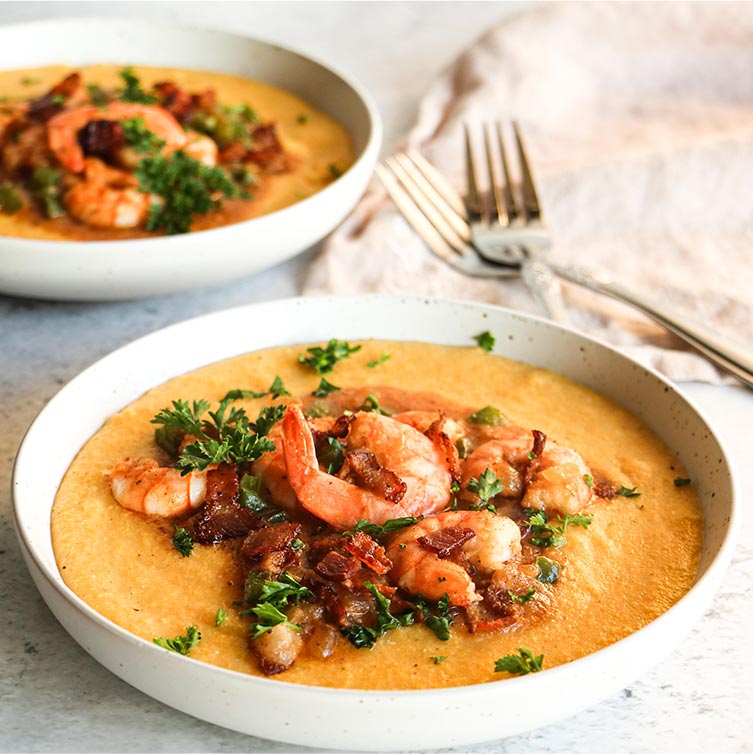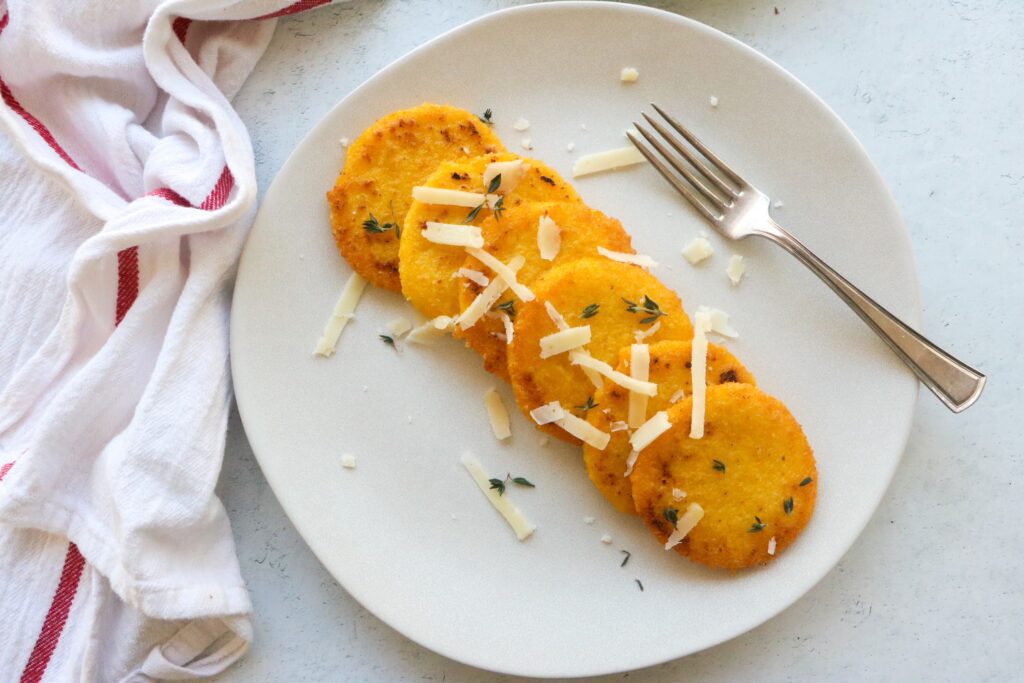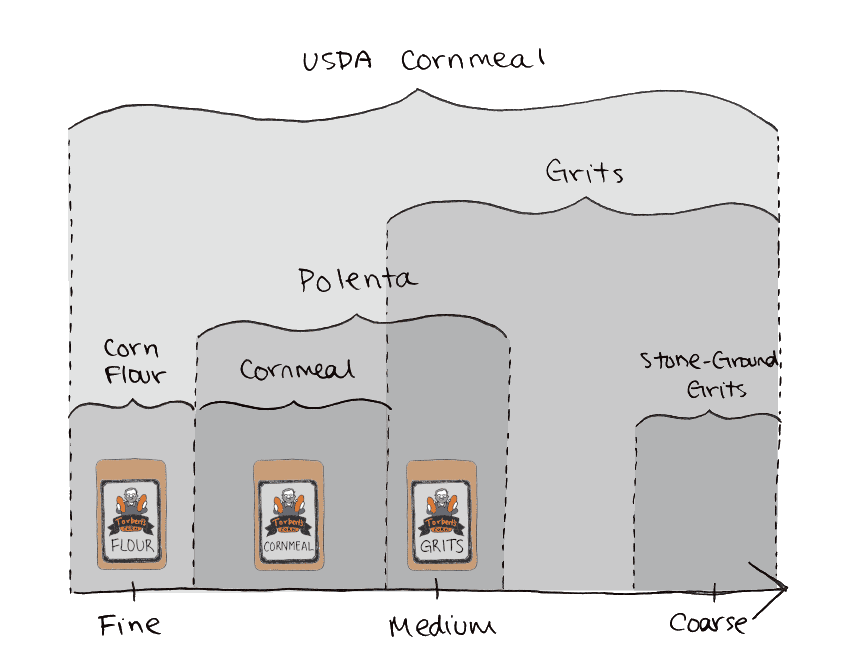
Polenta and Grits and Flour, Oh My!
Corn has been a part of the human diet for thousands of years, so naturally, we’ve found hundreds of ways to eat it. As corn spread across the globe, it also gained new names and culinary traditions. Grits in America can be called ugali in Kenya, coucou in Barbados, polenta in Europe, or saab in Ghana: the list is basically unending. It’s therefore no surprise that as names have changed and developed, people’s definitions and understanding of corn products are different, depending on who you ask. So, we here at Professor Torbert’s thought we’d help clear up some of the confusion by explaining how we interpret a number of commonly used names for ground corn products used in the U.S.
Cornmeal

Cornmeal is the most basic kind of ground corn product, and as such is the source of a lot of confusion. According to the USDA, any ground corn product is cornmeal. This means that the finest corn flour, as well as the coarsest ground grits of any color, would all be considered cornmeal. In practice, however, cornmeal typically refers to a specific type of ground corn product that you can buy at the store. Cornmeal is typically finer ground and made from yellow corn, but not fine enough to be flour. This cornmeal is what’s often used for cornbread, or to dust the bottoms of pizzas to prevent sticking. Think of it as your “everyday” cornmeal. Professor Torbert’s Orange Cornmeal is just that: finely ground cornmeal perfect for cornbread, corn muffins, pancakes, pizza crust, breading and fry batter! Try it out with our homemade corn dog or fried chicken recipe – both family favorites that highlight the buttery, nutty taste of the Orange Corn and crisp to perfection when fried!
Grits and Polenta
Another source of confusion stems from the way people refer to some types of ground corn products as grits and polenta. Grits and polenta are technically both cornmeal porridges, but over time the words grits and polenta have come to mean the dish itself, as well as the specific type of cornmeal used to make them. While grits and polenta by definition are very similar, they differentiate themselves in the culture surrounding them.

Grits
Associated with the American South, grits is a cornmeal porridge traditionally made from medium or coarsely ground, white dent corn. The specific type of corn, however, has come to matter less over time. The word “grit” actually comes from the Old English word “grytt,” which just meant coarsely ground grain, not even specifying corn. The culture and preparation around grits have become arguably more important than the kind of corn used, with Southerners and traditionalists swearing by whole grain grits that take about 45 minutes to cook, and less patient or perhaps hungrier cooks preferring “quick grits,” which take only about 10 minutes. Grits are culturally associated with cheese, sausage, shrimp, and cream. Grits are considered a staple of Southern cuisine, and have strong historical roots in the culinary traditions of Native Americans and enslaved peoples of African descent. While everyone has different opinions on what grits actually are, what can generally be agreed upon is that grits are medium or coarsely ground, and can be used to make delicious American dishes. If you haven’t already, try using Professor Torbert’s Orange Corn grits in some of our Southern favorites such as our classic shrimp and grits, or our fried green tomatoes!

Polenta
Polenta is an Italian cornmeal porridge. Similar to grits, the word polenta originally referred to any porridge, and the word existed in Italian before corn even arrived in Italy from the Americas. Over time, polenta began to refer only to the porridge made traditionally from flinty yellow corn, but like grits, the culture around the food has become more important than the kind of corn used. The word polenta actually means “fine flour,” and as such, polenta is typically fine or medium ground. Originally, polenta was thought of as a dish for the poor and lower classes, but over time it has become a staple of Italian cuisine and can now even be found on the menus of fine dining establishments! Polenta can be prepared with herbs, or bolognese, or cooked very thick, sliced, and pan fried. Like grits, while polenta can mean different things to different people, polenta is typically finely or medium ground cornmeal, and turned into a delicious Italian porridge. Some of our favorite polenta recipes include our bolognese sauce with polenta and our polenta cakes – both highlight the delicious taste and texture of Professor Torbert’s Orange Corn and the versatility of our polenta! Consider trying them out for your next dinner party or gathering!
Honorable Mentions
Stone-Ground Grits
Stone-ground grits are grits made the old-fashioned way. As indicated by the name, they are ground between two stones, and as such are coarser than normal grits, and take longer to cook. This method also grinds the entire kernel, so both the endosperm and germ are kept in the grits, giving the grits a speckled look and a stronger corn flavor.

Corn Flour
Corn flour is ground so finely that it becomes a uniform yellow or white flour. It is also worth mentioning that in Europe, what they call corn flour is what Americans would call corn starch, which is very different from corn flour. American corn flour can be used in baked goods like cakes, but corn starch is used mostly to thicken sauces and soups. For inspiration on creative ways to incorporate corn flour into your cooking, try out our ice cream cone or our corn flour crepe recipe!
Professor Torbert’s Orange Corn
At Professor Torbert’s, you might have noticed that we sell polenta-grind grits, which is our way of saying that our product is perfect for both! As we mentioned, most of the differences between polenta and grits are more dependent on how you prepare the dish and the culture around it. Polenta can be finely or medium ground, and grits can be medium or coarsely ground. With our medium-ground Orange Corn, our product opens up the possibility of making any polenta or grits recipe your heart desires. Even if you prefer a polenta made from a finer grind of cornmeal, Professor Torbert’s Orange Cornmeal can be used to make a delicious polenta as well!

Whether you’re in love with Italian food, or more of a Southerner at heart, we want to help you incorporate the benefits of Orange Corn into your life!
Looking to try something new? Our Orange Corn Recipe Library includes a variety of cornmeal, grits, and polenta recipes. From our classic cornbread recipe, to creative desserts, and snacks there’s something for everyone!
For more information on types or corn and ground corn products check out these additional resources:
Online Etymology Dictionary – Grits
